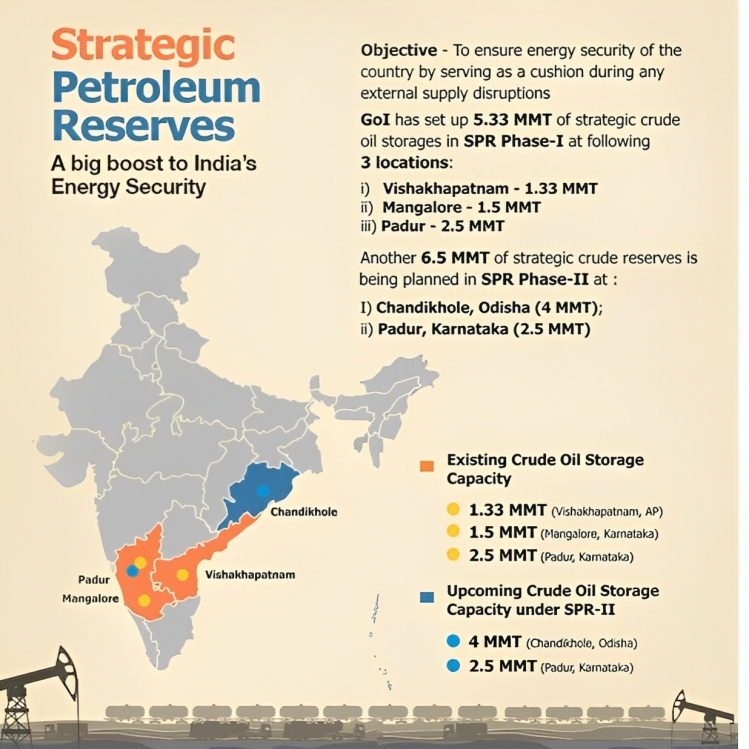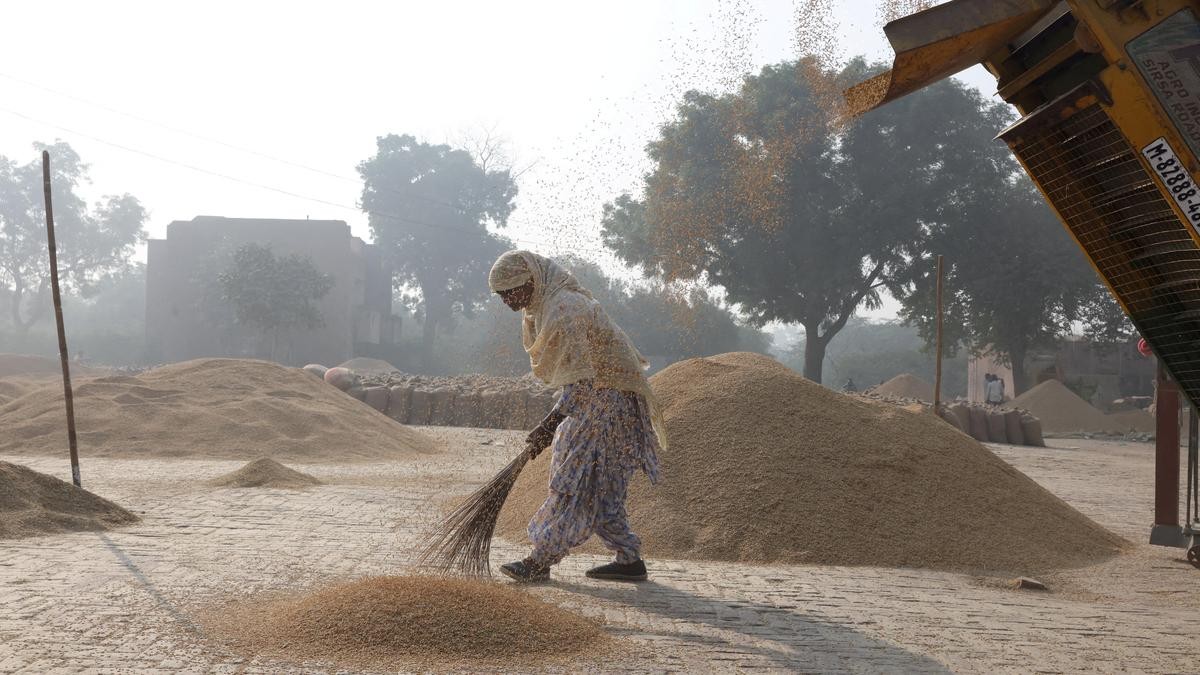
Copyright infringement not intended
Context: The Government of India has entrusted Engineers India (EIL), a state-owned engineering consultancy firm, with the task of exploring the possibility and feasibility of creating strategic oil reserves in salt caverns in Rajasthan. This is in line with the government's goal of increasing the country's strategic oil storage capacity to cope with potential disruptions in the global oil supply chain.
Details
- If the project is successful, India could have its first salt cavern-based oil storage facility. The country's three existing strategic oil storage facilities at Mangaluru and Padur in Karnataka and Visakhapatnam in Andhra Pradesh are made up of excavated rock caverns.
What are salt caverns and how are they different from rock caverns?
- Salt caverns are developed by the process of solution mining, which involves pumping water into geological formations with large salt deposits to dissolve the salt.
- After the brine (water with dissolved salt) is pumped out of the formation, the space can be used to store crude oil. The process is simpler, faster, and less cost-intensive than developing excavated rock caverns.
- Rock caverns are carved out of hard rock formations by blasting and drilling, creating chambers that can also store oil.
- Salt cavern-based oil storage facilities are also naturally well-sealed, and engineered for rapid injection and extraction of oil. This makes them a more attractive option than storing oil in other geological formations, according to a report by the Environmental Solutions Initiative at the Massachusetts Institute of Technology (MIT).
Salt Caverns
- Salt caverns are created by dissolving salt deposits with water, and then pumping out the brine (salt water) to create a hollow space. This process is much faster and cheaper than excavating rock caverns and can be done in flat or low-lying areas where salt deposits are found.
- Salt caverns also have several advantages over rock caverns for storing oil. Salt caverns are naturally well-sealed and have low oil absorbency, which prevents leakage and contamination of the stored oil.
Salt caverns are relatively easy and cheap to create and operate
- One of the main advantages of salt caverns is that they are relatively easy and cheap to create and operate. The process of solution mining is faster and simpler than excavating rock caverns, which requires more time, labour, and equipment.
- Salt caverns can also be located closer to the surface than rock caverns, which reduces the drilling costs and the risk of leakage.
Salt caverns are naturally well-sealed and suitable
- Another advantage of salt caverns is that they are naturally well-sealed and suitable for rapid injection and extraction of oil. The salt lining acts as a natural barrier against liquid and gas migration, preventing oil from escaping or contaminating groundwater.
- Salt caverns can also withstand high pressure and temperature variations, allowing for faster filling and emptying of oil. This makes them ideal for emergencies or market fluctuations when the oil needs to be released or stored quickly.
Salt caverns Require a large amount of water
- Salt caverns also have some drawbacks. One of them is that they require a large amount of water to create and maintain. The water used for solution mining has to be treated to prevent corrosion and bacterial growth, which adds to the operational costs.
- The water also has to be disposed of safely after extracting the brine (water with dissolved salt), which can pose environmental challenges. The brine can contain harmful substances such as heavy metals or radioactive elements, which have to be removed before discharging into surface water or injecting into deep wells.
Salt caverns are limited by the availability and quality of salt deposits
- Another drawback of salt caverns is that they are limited by the availability and quality of salt deposits. Not all regions have suitable salt formations that can be used for oil storage.
- The salt deposits have to be thick enough, pure enough, and deep enough to ensure stability and safety. The salt also has to be homogeneous and free of faults or fractures that could compromise the integrity of the caverns.
Salt caverns are not only used for storing oil but also for other liquid fuels and natural gas. They can also be used for storing compressed air and hydrogen, which are emerging as clean energy sources. Salt caverns are therefore a versatile and efficient option for underground energy storage.

Rock caverns
- They can be built in more locations and more diverse geological settings. Rock formations such as granite, sandstone, or limestone can be found in many parts of the world and can be used to create rock caverns for oil storage.
- Rock caverns are created by excavating hard rock formations, such as granite or basalt, using explosives or mechanical methods. They require extensive engineering and construction work and can take several years to complete.
- Rock caverns are usually located in mountainous areas or near coastlines, where suitable rock formations are available.
They do not require water for their creation or maintenance
- Another advantage of rock caverns is that they do not require water for their creation or maintenance. This reduces the environmental impact and the operational costs of rock cavern storage facilities.
- Rock caverns also do not produce brine as a by-product, which eliminates the need for brine disposal or treatment.
They are more expensive and difficult to create and operate
- Rock caverns also have some disadvantages compared to salt caverns. One of them is that they are more expensive and difficult to create and operate. The process of excavating rock caverns involves more technical challenges and risks than solution mining.
- Rock blasting and drilling can cause vibrations, noise, dust, and debris, which can affect nearby communities and ecosystems. Rock caverns also require more engineering and monitoring to ensure their stability and safety.
Less suitable
- Another disadvantage of rock caverns is that they are less suitable for rapid injection and extraction of oil than salt caverns.
- Rock formations have higher porosity and permeability than salt formations, which means that they can absorb or release oil more easily. This can result in lower oil recovery rates and higher oil losses due to evaporation or leakage.
- Rock formations also have lower thermal conductivity than salt formations, which means that they are more sensitive to temperature changes caused by filling or emptying the oil.
Less common
- Rock cavern-based oil storage facilities are less common than salt cavern-based ones, but they exist in some countries such as Japan, China, India, Norway, Sweden, Finland, France, Germany, Italy, and Spain.
Strategic Petroleum Reserves (SPR)
Why need SPR?
- Strategic Petroleum Reserves (SPR) are large stockpiles of crude oil that are maintained by governments or private entities to ensure energy security and mitigate the impact of supply disruptions. SPRs are essential for countries that rely heavily on oil imports, such as India, which imports about 85% of its crude oil needs.
Oil markets are often volatile
- Oil is a vital commodity that fuels the global economy and affects almost every aspect of our lives. However, oil markets are often volatile and subject to geopolitical uncertainties, natural disasters, technical failures, and other factors that can cause sudden and severe shortages of oil supply.
- Such shortages can have serious consequences for the economy, national security, and public welfare of oil-importing countries.
- For example, in 1973-74, the Organization of Arab Petroleum Exporting Countries (OAPEC) imposed an oil embargo on the United States and other countries that supported Israel in the Yom Kippur War. This resulted in a quadrupling of oil prices and a global recession. In response, the United States established the SPR in 1975 under the Energy Policy and Conservation Act (EPCA) to reduce its vulnerability to future oil shocks.
Strategic Petroleum Reserves (SPR) in India
- India also recognizes the need and significance of SPRs for its energy security and economic stability. India is the world's third-largest consumer and importer of crude oil, with a demand of about 5 million barrels per day.
- India's dependence on oil imports makes it vulnerable to supply disruptions and price fluctuations in the international market. To address this challenge, India has established the Indian Strategic Petroleum Reserve Limited (ISPRL), a government-owned company that manages SPR facilities at three locations:
- Vishakhapatnam (1.33 MMT), Mangaluru (1.5 MMT), and Padur (2.5 MMT). These facilities have a combined storage capacity of 5.33 MMT, which can meet about 9.5 days of India's crude oil requirement.
- In addition, India has given 'in principle' approval for establishing two more SPR facilities at Chandikhol (4 MMT) and Padur (2.5 MMT), which will increase the total storage capacity to 11.83 MMT, equivalent to about 21.5 days of India's crude oil requirement.
- India has also taken advantage of low crude oil prices in 2020 to fill up its existing SPRs, leading to notional savings of about INR 5000 crore.

Significance
- The Strategic Petroleum Reserves (SPR) are a vital asset for ensuring the energy security and economic stability of a country. They are large stockpiles of crude oil that can be tapped in times of emergency or supply disruption, such as war, natural disasters, or geopolitical tensions
- They are not only beneficial for individual countries but also for global energy security and stability. SPRs can act as a buffer against sudden spikes in oil prices and demand, which can affect the economic growth and social welfare of many countries.
- They can also facilitate international cooperation and coordination in times of crisis, as exemplified by the collective action of the International Energy Agency (IEA) members in releasing 60 million barrels of oil from their SPRs in 2011 to offset the supply disruption caused by the Libyan civil war.
- The SPRs are a strategic tool for enhancing energy security and resilience in an uncertain and volatile world. They can help mitigate the impact of supply shocks, stabilize prices, and support economic growth.
- They can also serve as a deterrent against potential adversaries who may use oil as a weapon or a bargaining chip. The SPRs are therefore a significant component of national and international energy policy.
Challenges and Way Forward for Strategic Petroleum Reserves (SPR) in India
- India's SPR capacity is still inadequate compared to the International Energy Agency (IEA) norm of 90 days of net oil imports for its member countries. Moreover, India faces several challenges in developing and managing its SPR facilities, such as:
- High capital and operational costs
- Limited domestic storage sites
- Logistical constraints
- Legal and regulatory issues
- Geopolitical uncertainties
Financing the SPR projects
- One of the major challenges for India's SPR program is the high cost of building and maintaining underground storage caverns. The first phase of the SPR program, which involved setting up three facilities at Vishakhapatnam, Mangalore and Padur with a combined capacity of 5.33 MMT, cost about $600 million.
- The second phase, which involves adding two more facilities at Chandikhol and Padur with a total capacity of 6.5 MMT, is estimated to cost about $1.6 billion.
The government has been exploring various options to finance the SPR projects, such as:
- Public-private partnerships (PPPs)
- Leasing out part of the storage capacity to foreign oil producers or traders
- Issuing bonds or raising funds from multilateral agencies.
However, each of these options has its advantages and disadvantages in terms of risk-sharing, revenue generation, operational control and strategic autonomy. For instance:
- PPPs may reduce the financial burden on the government but may also compromise the national interest in times of crisis.
- Leasing out part of the storage capacity may generate income for the government but may also limit its access to the stored oil.
- Issuing bonds or raising funds from multilateral agencies may increase the debt burden on the government and expose it to external pressures or conditionalities.
Adopting a hybrid financing model
- A possible way forward for financing the SPR projects is to adopt a hybrid model that combines different sources of funding and balances the trade-offs between them. For example:
- The government could use its budgetary resources or borrowings to fund the core strategic storage capacity that is reserved for emergency use only.
- The government could lease out or partner with private or foreign entities for the additional commercial storage capacity that can be used for regular operations or revenue generation.
- This would ensure that India has adequate reserves to meet its energy security needs while also leveraging its SPR assets to enhance its economic and diplomatic interests.
Finding suitable storage sites
- Another challenge for India's SPR program is finding suitable geological formations for storing crude oil underground. The ideal storage sites should have:
- High porosity and permeability
- Low seismic activity
- Adequate depth and thickness
- Stable temperature and pressure conditions
- Minimal environmental impact
- Proximity to refineries or ports
- However, such sites are scarce in India and most of them are located along the coastal regions, which are prone to natural disasters or security threats. Moreover, acquiring land for building SPR facilities may face legal or social hurdles due to land ownership issues or public opposition.
Exploring alternative storage technologies
- A possible way forward for finding suitable storage sites is to explore alternative storage technologies that can overcome some of the limitations of underground caverns. For example:
- India could consider using above-ground tanks or floating storage units that can be deployed on land or sea respectively.
- India could also look into using depleted oil or gas fields or salt domes as potential storage sites.
- These technologies may offer more flexibility, scalability and accessibility than underground caverns but may also entail higher costs, maintenance requirements and safety risks. Alternatively, these technologies may offer lower costs, higher capacity and longer durability than underground caverns but may also pose technical, environmental or regulatory challenges.
Managing the SPR operations
- A challenge for India's SPR program is managing the operational aspects of the storage facilities, such as filling, drawing, rotating and maintaining the stored oil. These aspects require careful planning, coordination and execution to ensure the optimal utilization, quality and availability of the oil reserves.
- India faces several constraints and uncertainties in managing its SPR operations, such as:
- Limited domestic production and refining capacity
- Fluctuating global oil prices and demand
- Changing geopolitical scenarios and regional conflicts
- Evolving legal and contractual obligations
- Emerging technological innovations
Developing a robust SPR policy framework
- Need to develop a robust policy framework that guides the decision-making and implementation processes for the SPR program. The policy framework should define:
- The objectives, roles and responsibilities, governance structures, operational procedures, performance indicators and review mechanisms for the SPR program.
- The key issues and challenges related to the financing, storage, filling, drawing, rotating and maintaining of the oil reserves.
- The policy framework should be flexible and adaptive to accommodate the changing dynamics and uncertainties in the domestic and international oil markets.
Conclusion
- In conclusion, SPRs are a vital tool for ensuring energy security and mitigating the impact of supply disruptions for oil-importing countries like India. They can help reduce the vulnerability of these countries to external shocks and enhance their economic resilience and national security. They can also contribute to global energy stability and cooperation by providing a cushion against oil market volatility and facilitating collective action in times of emergency.
|
PRACTICE QUESTION
Q. Strategic Petroleum Reserves (SPR) is an important component of India's energy security strategy. However, developing and maintaining SPR also poses several challenges. How can India address these challenges and ensure that its SPR policy is effective, efficient and sustainable? What are the potential benefits and drawbacks of SPR for India's economy, society and environment?
|

https://indianexpress.com/article/explained/explained-economics/explained-economics-oil-reserves-in-salt-caverns-8643242/













